
Best crypto exchanges in Australia for 2025
- Kraken – Best overall, extra features and advanced trading
- eToro – Best for copy trading
- Swyftx – Best for beginners
- Coinbase – Best for long term investors
- OKX – Best for instant purchases
- Coinstash – Best exchange for altcoins
- CoinSpot – Best local exchange
- Bybit – Best crypto app
- Binance – Highly commended for advanced trading
- CoinJar – Best exchange for value
- KuCoin – Best exchange for emerging altcoins
- Coinstash – Best for crypto SMSFs
How did we pick these exchanges?
We analyse more than 500 across 19 cryptocurrency platforms in Australia to find winners across a range of categories. Approximately 100 hours went into data collection, review and analysis.
Awards are based on quantitative criteria which are weighted and scored for each category. We also identified exchanges that are particularly strong on certain individual features such as copy trading or learn and earn programs.
Read the full methodology for our crypto trading platform awards
Compare the best crypto exchanges in Australia
Use our table to compare the leading crypto exchanges or platforms on fees, fiat currencies, deposit methods and more. Once you've found the right fit, select Go to site to get started.
Compare crypto exchanges
Compare other products
We currently don't have that product, but here are others to consider:
How we picked these1. Kraken: Best overall exchange
Kraken
Finder Score
Supported cryptos
Fiat currencies
Kraken is widely recognised as one of the leading crypto exchanges in the world and was a two-time winner in the most recent Finder Awards. It won in the categories of Best Overall and Advanced Trading, and was also named Highly Commended in the Beginners category.
The platform features a professional trading interface, competitive fees, staking, swaps, AUD deposits and withdrawals, an NFT marketplace and an education hub.
Kraken regularly exceeds a daily trading volume of US$500 million and is renowned for its deep liquidity across high market cap trading pairs. Traders utilising Kraken Pro can take advantage of various order types such as stop-loss, market and limit orders with inbuilt TradingView charts.
Trading fees work on a volume system, meaning users trading in high volumes are rewarded with fee discounts, which go as low as zero for maker orders and 0.1% for taker orders.
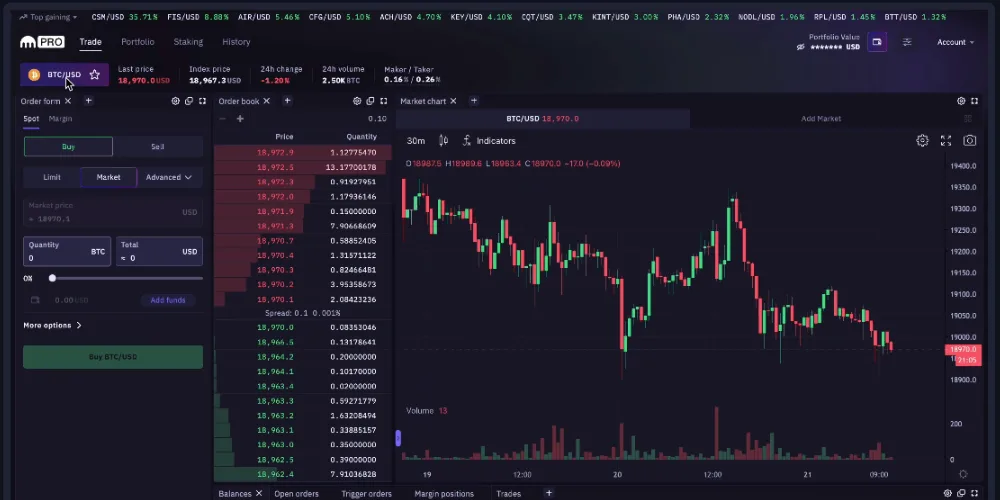
- Registered with AUSTRAC
- Advanced order types
- Customisable charting features
- Wide range of fiat currencies and forex trading
- Founded in 2011, one of the longest-running crypto exchanges
- Over 280 USD trading pairs
- Fewer assets than some competitors
- Limited AUD pairs on the spot market
| Deposit Methods | Debit card, Credit card, Bank transfer, Paypal, Cryptocurrency |
|---|---|
| Deposit Fees | Bank transfer, PayID or OSKO: None Cryptocurrency: Fees vary Credit and debit card: Fees vary |
| Withdrawal Fees | Bank transfer/OSKO: None ($5 minimum withdrawal) SWIFT: $55 ($150 minimum withdrawal) Cryptocurrency: Network fees apply |
| Trading Fees | Maker: 0.20 – 0.25%Taker: 0.35 – 0.40% |
2. eToro: Best for copy trading
eToro Crypto
Finder Score
Supported cryptos
Fiat currencies
AUSTRAC-registered
eToro pioneered the concept of copy trading back in 2010. Since then, the platform has expanded to include various social features, with a Facebook-style newsfeed that lets you engage directly with other traders.
eToro is highly commended across multiple categories in Finder's crypto trading platform Customer Satisfaction Award for 2025, with its Australian users recognising it as a loved and recommended brand. eToro was also recognised for trust, value and quality service.
In particular, eToro's unique copy trading feature allows you to view and mirror trades made by experienced investors. With a minimum of US$200, you can automatically repeat trades from some of eToro's top-performing crypto traders. There is no additional fee charged for this service.
Beyond copy trading, eToro provides a comprehensive social experience, making it just as much a social media platform as a broker. Traders can discuss strategies, speculate on prices and share important news.
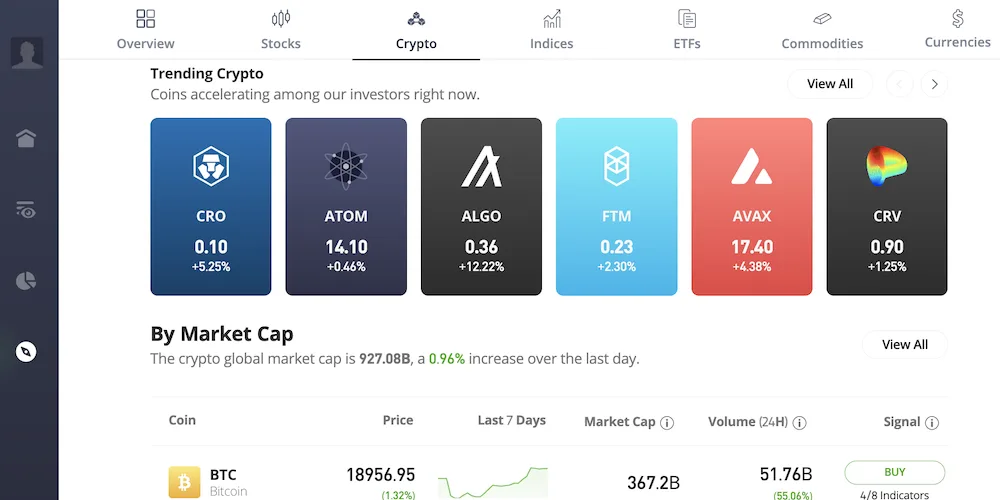
- Registered with ASIC
- Supports copy trading for crypto and stocks
- Pioneers of copy trading
- Strong community and social focus
- Offers an insurance fund
- Picking the right trader to copy can be difficult
- Foreign exchange fees for AUD deposits
- Limited range of cryptocurrencies
- Fees and spreads can be higher than on crypto exchanges
| Deposit Methods | Bank transfer, Credit card, Cryptocurrency, Debit card |
|---|---|
| Deposit Fees | Debit card: 2% FX fee |
| Withdrawal Fees | AU$5 (min. of US$30) Up to a 3% currency conversion fee for AUD |
| Trading Fees | 1.00% |
What Finder Members are saying about eToro
eToro users praise the platform for its ease of use, social trading features like copytrading, and its customer support which includes a phone-based option.
However, it's crystal clear what users dislike – the fees. Users complain about withdrawal fees as well as spreads.
3. Swyftx: Best for beginners
Swyftx
Finder Score
Supported cryptos
Fiat currencies
Swyftx is an Australia-based crypto exchange that features more than 440 assets and boasts over 700,000 users. It was named the best exchange for Beginners in the most recent Finder Awards thanks to its educational tools, user support and demo mode.
It was also the most recommended brand in Finder's Customer Satisfaction Awards, with 91% of users saying they would recommend the platform.
With thousands of 5-star reviews on Trustpilot and a local Australian customer support team it's no surprise Aussies rated the brand so highly.
The platform has an easy-to-navigate and beginner-friendly UI and features an education hub where you can take crypto courses to learn new skills and test your knowledge with quizzes.
The Swyftx mobile app offers a comprehensive user experience with all the same features supported on the desktop exchange. It is available for download via the App Store or Google Play.
Swyftx is AUSTRAC-registered, independently audited and holds all customer balances on a 1:1 basis. Once you've signed up and completed the KYC verification process, you're ready to start trading.
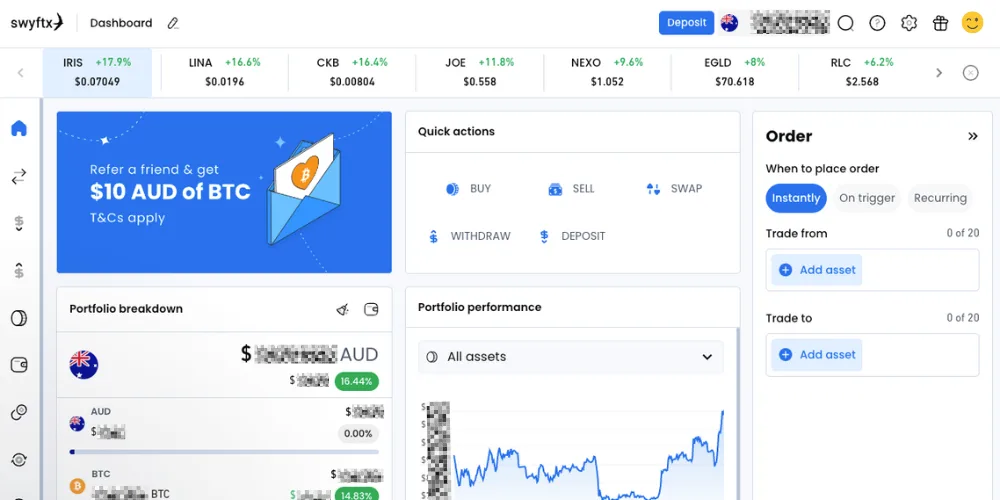
- Registered with AUSTRAC
- Simplified dashboard – quickly view your assets and their performance
- 440+ cryptos available to buy, sell and trade
- Demo account available – test set-ups and strategies on the go
- Thousands of 5-star reviews on Trustpilot
- Australia-based customer support
- Mobile charting is less comprehensive than some competitor apps
- Limited range of order types
- Beginner-oriented UX – advanced traders may prefer a tier-1 global exchange
| Deposit Methods | Bank transfer, Credit card, Cryptocurrency, Debit card |
|---|---|
| Deposit Fees | Bank transfer: $0 Card: $0 PayID: $0 Cryptocurrency: $0 |
| Withdrawal Fees | AUD: $0 Cryptocurrency: $0 (network fees apply) |
| Trading Fees | 0.1 – 0.6% |
What our users are saying about Swyftx
Swyftx users consistently praise its customer service team, with many users saying how quick they were to respond. Beginner cryptocurrency investors appear to have an easy time using the platform.
Criticism of Swyftx appears to revolve around accounts being banned and users struggling to retrieve funds.
4. Coinbase: Best for long term investors
Coinbase Australia
Finder Score
Supported cryptos
Fiat currencies
AUSTRAC-registered
Launched in 2012, Coinbase is one of the longest-running and most reputable crypto exchanges. It has over 110 million verified users and over 310 coins and tokens listed, including most major trading pairs.
Coinbase emphasises its goal to help bring Web3 to the masses and educate and onboard beginners. As part of this, the platform offers a learn-to-earn hub, which we've recognised as the best in its class.
Coinbase Learn is easy to use and provides a gamified experience, which makes it engaging and accessible for users of all levels.
After signing up and verifying your Coinbase account, you can start trading, earning and learning. The platform is easy to use and markets typically offer deep liquidity.
Coinbase also has 24/7 customer support and a robust security system, protecting users' funds and personal information.
- Registered with AUSTRAC
- Simple sign-up process
- Beginner or advanced trading options
- Incentivised learn-to-earn feature
- Includes trade, earn and NFT platforms
- Hundreds of markets and several trading pairs, including USDC, BTC and ETH
- Derivatives trading is not supported in Australia
- Advanced trading features are not as comprehensive as some competitor exchanges
- Crypto borrowing and lending are not available in Australia
| Deposit Methods | Debit card, Bank transfer, Paypal, Cryptocurrency |
|---|---|
| Deposit Fees | AUD: None using bank transfer or PayID Cryptocurrency: None |
| Withdrawal Fees | AUD: None Cryptocurrency: Fees vary |
| Trading Fees | Maker fee: 0.40%Taker fee: 0.60% |
5. OKX: Best for instant purchases
OKX
Finder Score
Supported cryptos
Fiat currency
AUSTRAC-registered
OKX is a cryptocurrency exchange that was founded in 2017 and is now one of the largest exchanges in the world based on trading volume and users. It was named Highly Commended in the categories of Best Overall and Advanced in the most recent Finder Awards.
It lets you instant buy more than 280 cryptocurrencies with AUD with competitive fees and an extensive range of payment options.
It is also one of the few exchanges that offers derivatives trading (including futures, options and perpetual swaps) in Australia. You’ll need to be a verified wholesale client to access derivatives trading.
OKX publishes monthly proof of reserve snapshot to verify it holds funds to cover all user assets.
- Straightforward exchange interface
- Educational resources
- Over 280 instant buy cryptos available
- Trade with multiple fiat currencies
- Poor customer service reviews
| Deposit Methods | Bank transfer, Credit card, Cryptocurrency, Debit card |
|---|---|
| Deposit Fees | AUD: None Bank transfer: None Cryptocurrency: none (Network fees apply) Network fees may apply |
| Withdrawal Fees | Bank withdrawal: None Cryptocurrency: none (Network fees apply) |
| Trading Fees | 0.500% |
| Advanced Trading Features | Yes |
6. Coinstash: Best exchange for altcoins
Coinstash
Supported cryptos
Fiat currency
AUSTRAC-registered
- 1,120+ listed coins
- Specialised tax reporting
- 1-1 SMSF consultations
- Trade using AUD
- You can find lower trading fees elsewhere
- Its DeFi Connector feature is not for beginners
| Deposit Methods | Bank transfer, Cryptocurrency, Osko, PayID |
|---|---|
| Deposit Fees | PayID: None Osko: None |
| Withdrawal Fees | Cryptocurrency: Fees vary AUD: None |
| Trading Fees | 0.13 – 0.85% |
7. CoinSpot: Best local exchange
CoinSpot
Finder Score
Supported cryptos
Fiat currency
AUSTRAC-registered
CoinSpot is one of Australia's longest-running exchanges and has over 2.5 million registered users. It's an excellent choice for beginner investors looking to dip their toes into the world of cryptocurrencies. CoinSpot received Highly Commended awards in the best Overall and Beginner categories of the most recent Finder Awards.
This Australia-based exchange has a user-friendly interface, making it easy for newcomers to navigate the platform and start trading over 530 cryptocurrencies.
One of the stand-out features of CoinSpot is its fast and straightforward purchasing process. The platform supports various payment options for AUD, including POLi payments, BPAY, and PayID, making it easy for investors to purchase cryptocurrencies quickly and efficiently.
In addition to speedy purchases, CoinSpot offers great value fees at just 0.1% for market and OTC trades. Instant buys, sells and swaps incur a 1% charge.
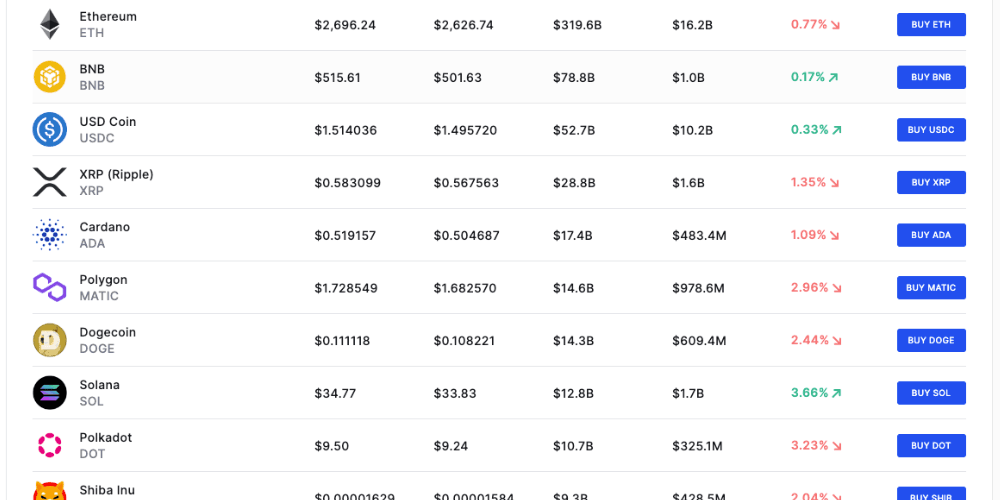
- Registered with AUSTRAC
- Easy to navigate UI, with prices displayed in AUD
- AUD payment methods include POLi, PayID, BPAY and cash deposits
- Buy crypto bundles – a group of projects in a specific niche
- Inbuilt NFT marketplace
- Holds ISO 27001 security certificate and completed a successful External Statutory Financial Audit
- Advanced trading features are not as comprehensive as some competitor exchanges
- Crypto borrowing and lending aren't available
- Instant swap fees of 1% can be costly for large orders
| Deposit Methods | Bank transfer, Credit card, Cryptocurrency, Debit card |
|---|---|
| Deposit Fees | Bank transfer and PayID: None Cash: 2.5% Card: 1.22% Cryptocurrency: None PayPal: 0.5% |
| Withdrawal Fees | AUD: None Cryptocurrency: Fees vary PayPal: 0.5% |
| Trading Fees | 1.00% |
What our users are saying about CoinSpot
A common theme among CoinSpot users is praise for how easy the platform is to use and its beginner-oriented features. Customer support is also well regarded.
As for criticisms, they tend to focus on issues with account verification and security measures that some users find inconvenient.
8. Bybit: Best crypto app
Bybit
Finder Score
Supported cryptos
Fiat currency
Bybit is a cryptocurrency exchange founded in 2018 and headquartered in Singapore. It's best known for its expansive range of features, in-depth trading experience and a best-in-class mobile app for trading on the go.
The Bybit app features a user-friendly interface that makes navigating and placing trades simple. It includes advanced trading tools such as real-time charts, order book depth and price alerts to help you make informed decisions and stay updated with market trends.
Bybit's uses industry-standard security measures to protect user data and funds. It has 2-factor authentication (2FA) and biometric authentication (fingerprint and face recognition).
The mobile app is available for download via the Apple store and Google Play and supports multiple languages including English, Chinese, Japanese, Korean and Spanish.
- Bybit's platform is easy to navigate even for new users
- Advanced trading tools such as real-time charts, order book depth and price alerts
- Bybit markets typically have deep liquidity
- Fully functional mobile app makes trading on the go easy
- Advanced security measures include multi-signature wallets, cold storage and 2FA
- Not registered with AUSTRAC
- Not all features are available to Australian users
- Foreign exchange fees for AUD deposits
| Deposit Methods | Credit card, Cryptocurrency, Debit card |
|---|---|
| Deposit Fees | AUD: Fees vary Cryptocurrency: None |
| Withdrawal Fees | Fiat: Fees vary Cryptocurrency: Fees vary ATM Withdrawal: 2% (after the first 100 USD monthly) |
| Trading Fees | Maker: 0.03—0.10%Taker: 0.045—0.10% |
9. Binance: Highly commended for advanced trading
Binance Australia
Finder Score
Supported cryptos
Fiat currencies
AUSTRAC-registered
With low spot market fees, a feature-rich trading platform and a vast selection of cryptocurrencies and trading pairs, Binance was named Highly Commended awards in the most recent Finder Awards in the category of Advanced Trading.
You can customise your trading interface with multiple charts, indicators and data feeds. There is a desktop app available for Windows and Mac which offers greater customisation and immersion.
There are also trading bots with preset strategies for grid trading, rebalancing, dollar-cost averaging and TWAP.
Binance users can benefit from using BNB to pay for trading fees, which results in a 25% discount on spot trades. While it formerly offered AUD deposits and withdrawals, this feature was removed in 2023.
Boasting around 258 million registered users and more trading volume than any competitor, Binance is the world's largest exchange.
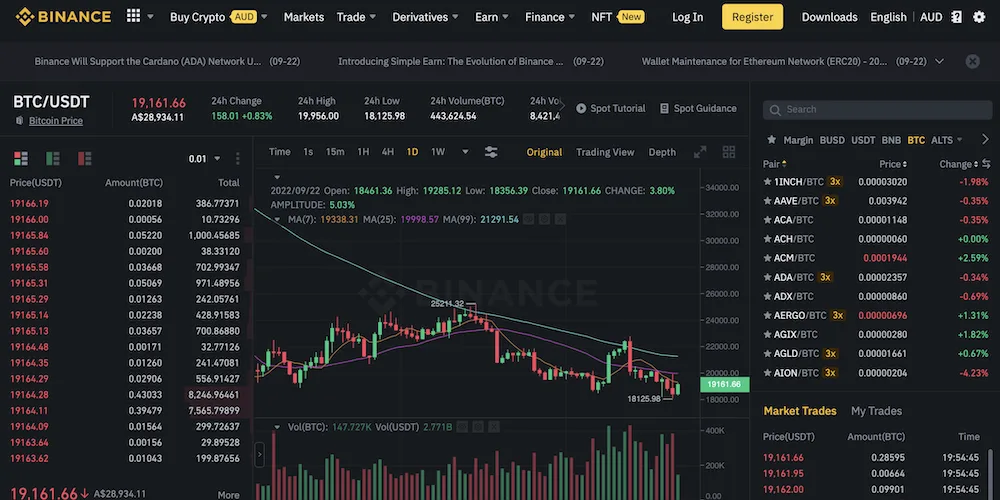
- Registered with AUSTRAC
- Low spot market fees
- Huge range of supported cryptocurrencies
- Comprehensive earning features
- Smartphone app offers Lite mode for beginners
- Zero-fee Bitcoin spot trading for select pairs
- Does not accept AUD deposits, trades or withdraws
- Fees to buy crypto using AUD cards can be high
- Website can be overwhelming for beginners
- Poor customer service score on Trustpilot
- Ongoing regulatory issues in the US, the UK and Japan
- Target of an on-going civil enforcement action by the US CTFC
| Deposit Methods | Credit card, Cryptocurrency, Debit card |
|---|---|
| Deposit Fees | Cryptocurrency: None |
| Withdrawal Fees | AUD: Not supported Cryptocurrency: Fees vary |
| Trading Fees | Maker: 0.0110 – 0.1000%Taker: 0.0230 – 0.1000% |
What our users are saying about Binance
Reviews of Binance praise the smartphone app in particular, which offers all the features of the desktop exchange in a compact format. Users also enjoy the wide range of coins available as well as the extra features like staking.
Binance users appear to critique it for two main reasons – poor customer service and an overwhelming user interface that is not well suited for beginners. A small number of users expressed issues when trying to withdraw funds, which is hampered by poor customer support.
10. CoinJar: Best exchange for value
CoinJar
Finder Score
Supported cryptos
Fiat currencies
AUSTRAC-registered
CoinJar is a great pick for overall value due to its competitive fee structure across trading, deposits and withdrawals. It was named Highly Commended in the Best Overall category of the most recent Finder Awards. You can buy and sell more than 60 cryptocurrencies with as little as $10, and pay no fees on bank deposits and withdrawals.
There's a simple 1% fee on all crypto and fiat conversions, and a 2% fee on instant buys via card, Apple Pay and Google Pay. If you decide to setup recurring trades, this instant buy fee is reduced to 1%. For more advanced investors, the CoinJar exchange has maker and taker fees of 0.10% on fiat trading pairs, or 0.06% on crypto-to-crypto or crypto-to-stablecoin trading pairs.
CoinJar also offers a crypto card, bundles, a free app and SMSF support.
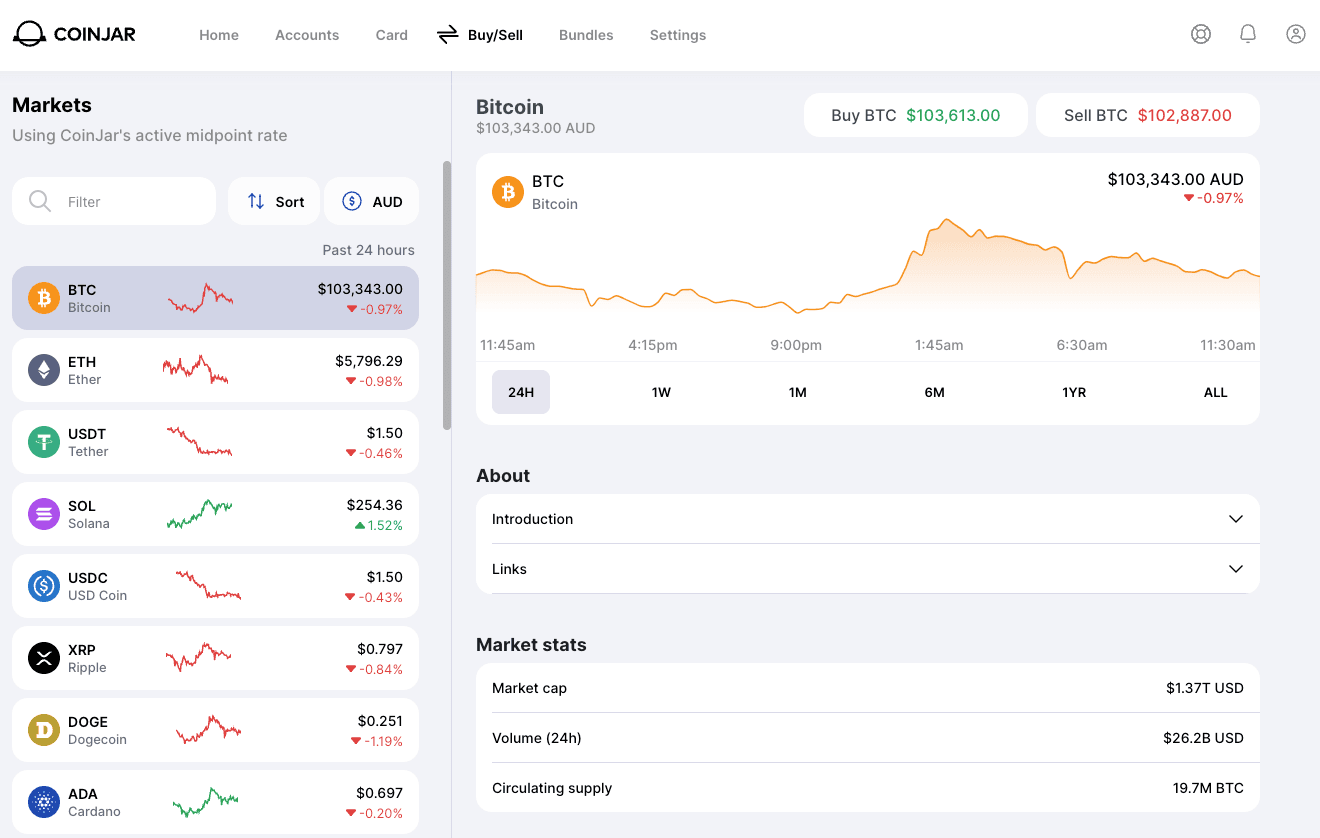
- Registered with AUSTRAC
- Competitive fees across the board
- Multiple fiat trading pairs
- Decent selection of cryptos
- Advanced trading platform
- Fewer assets than some competitors
| Deposit Methods | Bank transfer, Credit card, Cryptocurrency, Debit card |
|---|---|
| Deposit Fees | PayID: $0 Bank transfer: $0 SEPA: $0 Faster Payments: $0 Cryptocurrency: $0 |
| Withdrawal Fees | AUD: $0 Cryptocurrency: Network fees apply |
| Trading Fees | Maker: 0.02—0.10%Taker: 0.06—0.10% |
11. KuCoin: Best crypto exchange for emerging altcoins
KuCoin
Finder Score
Supported cryptos
Fiat currency
AUSTRAC-registered
KuCoin lists an impressive array of up-and-coming altcoins compared to other centralised crypto exchanges, which is why it's our winner for this category.
Usually, to buy trending altcoins, you must purchase them through a decentralised exchange (DEX) like Uniswap or PancakeSwap, which requires learning how to use a Web3 wallet and a blockchain.
With KuCoin, all you have to do is create your account and you'll have access to over 920 digital assets.
Many of these assets are brand new, untested and much riskier than coins like BTC and ETH, so tread carefully.
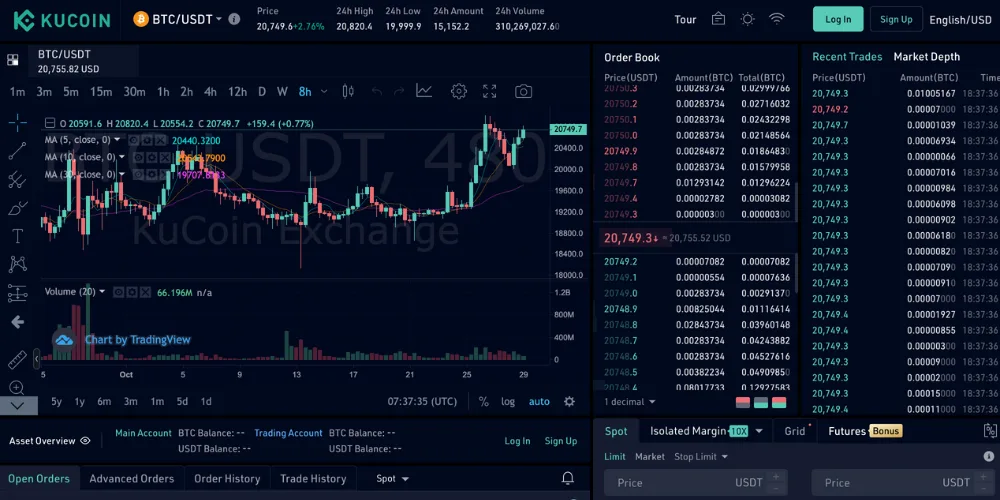
- Provides access to 920+ crypto assets
- Offers altcoin staking
- Relatively low trading fees
- Numerous poor customer service reviews
- Emerging assets can be higher-risk investments
| Deposit Methods | Bank transfer, Credit card, Cryptocurrency, Debit card, PayID |
|---|---|
| Deposit Fees | AUD: None using bank transfer or PayID Cryptocurrency: $0 |
| Withdrawal Fees | AUD: None Cryptocurrency: Fees vary |
| Trading Fees | Maker: 0.08% – 0.10% Taker: 0.08% – 0.10% |
| Advanced Trading Features | Yes |
12. Coinstash: Best for crypto self-managed super funds
Coinstash
Supported cryptos
Fiat currency
AUSTRAC-registered
Coinstash is an established Australian crypto exchange and has offered dedicated SMSF accounts since 2017.
It is AUSTRAC-registered, offers dedicated tax reporting and portfolio tracking, as well as 1-on-1 consults with SMSF specialists to help set up your account.
- 1,000+ listed coins
- Specialised tax reporting
- 1-1 SMSF consultations
- Trading fees aren't the most competitive
| Deposit Methods | Bank transfer, Cryptocurrency, Osko, PayID |
|---|---|
| Deposit Fees | PayID: None Osko: None |
| Withdrawal Fees | Cryptocurrency: Fees vary AUD: None |
| Trading Fees | 0.13 – 0.85% |
Finding the best crypto exchange in Australia
Our investment experts have analysed more than 25 cryptocurrency exchanges available in Australia to make it easier for you to select the right one. Our best crypto exchange picks are based on the Crypto Trading Platform Awards and Finder Customer Satisfaction Awards. We have only included exchanges that are registered with AUSTRAC or ASIC. Keep in mind that these picks are suggestions and that the exchange that is best for you will depend on your individual needs. There are other products on the market not included in our picks.
Why you can trust our research
19
Crypto exchanges analysed
500
data points
300+
hours of research
This is not an endorsement of cryptocurrency or any specific provider, service or offering. It is not a recommendation to trade or use any services.
Top 5 crypto exchanges for customer satisfaction
The Finder Customer Satisfaction Awards ask Australians which brands and products they trust and love the most. For the crypto trading platforms customer satisfaction awards, we surveyed hundreds of Australians to rate their crypto trading platform.
| Platform | Overall satisfaction | Trustworthy/reliable |
|---|---|---|
 | ★★★★★ 4.11/5 | 91% |
 | ★★★★★ 4.08/5 | 91% |
 | ★★★★★ 4.01/5 | 91% |
 | ★★★★★ 3.9/5 | 80% |
 | ★★★★★ 3.88/5 | 82% |
Which crypto exchanges accept AUD?
The following exchanges allow you to deposit AUD or buy crypto using Australian dollars:
- CoinSpot
- Kraken
- Coinbase
- Swyftx
- Coinstash
- BTC Markets
- Independent Reserve
- CoinJar
- Cointree
- Easy Crypto
- Digital Surge
- Day1x
Which crypto exchange has the lowest fees in Australia?
You can find a breakdown of the standard maker and taker fees of the major crypto exchanges in Australia in the table below. Please note that these are the fees for buying and selling crypto on the spot market, not via an instant purchase option.
| Exchange | Maker fee | Taker fee |
|---|---|---|
| Binance | 0.10% | 0.10% |
| Coinjar | 0.10% | 0.10% |
| KuCoin | 0.10% | 0.10% |
| ByBit | 0.10% | 0.10% |
| CoinSpot | 0.01% | 0.01% |
| Kraken | 0.23% | 0.40% |
| Coinbase | 0.40% | 0.60% |
| OKX | 0.70% | 0.70% |
| Swyftx | 0.60% | 0.60% |
| BTC Markets | -0.05% | 0.20% |
| Coinstash | 0.85% | 0.85% |
| eToro | 1.00% | 1.00% |
These fees are accurate as of December 15, 2025.
Buying and selling on an exchange's spot market is normally the cheapest way to trade cryptocurrency. However, the spot market fees listed below won't necessarily apply to every cryptocurrency you want to trade. For example, BTC Markets actually charges a -0.05% maker fee on BTC trading pairs, but a 0.85% fee on AUD pairs.
What if my bank blocks bank deposits or payments to crypto exchanges?
Many of Australia's biggest banks have imposed blocks or limits on certain crypto exchanges, including the Commonwealth Bank, Westpac, NAB and ANZ.
For example, Commonwealth Bank has a $10,000 limit on deposits to crypto exchanges each month. In July 2024, HSBC also announced that it would be blocking all transactions to crypto exchanges from its customers.
Banks may also outright block any transactions to exchanges they deem disreputable or insecure, but this is often extended to larger, respected exchanges as well.
In August 2024, users reported that deposits to Kraken were being blocked by banks including ING, Westpac and Macquarie Bank.
If your bank is blocking or reversing deposits to crypto exchanges, your first move should be to contact your bank directly. Depending on their response, you may need to try a different crypto exchange or open an account with a different bank that allows deposits to that exchange.
How to choose the best crypto exchange
It's important to research a wide range of platforms and compare the pros and cons of each option. The best crypto exchange for you depends on what you're looking for.
Consider the following factors when comparing crypto exchanges.

"I like to use Kraken for its instant AUD deposit options and staking options, while I also use Binance for its competitive fees, available tokens and high liquidity. Of course, this will be different for everyone, so make sure you're looking at an exchange that lines up with your own needs or priorities."
Using an AUSTRAC-registered exchange to buy cryptocurrency
There are plenty of places to buy crypto, including platforms founded here in Australia or based in locations all around the world. Exchanges headquartered locally are required to register with AUSTRAC and comply with requirements that don't apply to global platforms. Depending on your goals, this may have some benefits or drawbacks.
Pros
- Australia-based exchanges must comply with AUSTRAC's Anti-money Laundering (AML) and Counter-terrorism Financing (CTF) reporting obligations.
- You can usually buy crypto with Australian dollars.
- Exchanges in Australia typically support local payment methods.
- You may be able to access local customer support.
- Subject to local laws.
Cons
- You'll need to provide your personal details and proof of ID – a disadvantage if you want to trade anonymously.
- Overseas trading platforms may provide better liquidity.
- AUD-to-crypto prices are sometimes slightly higher than USD-to-crypto prices, meaning you sometimes pay a premium for buying directly with Australian dollars.
- Some features are simply not available on AUSTRAC-registered exchanges. For example, margin trading, DeFi features and some altcoins.
Finder survey: What assets do Australians invest in?
| Response | |
|---|---|
| None | 36.47% |
| Individual stocks | 34.39% |
| Real estate | 19.13% |
| Bitcoin | 18.33% |
| Index funds (e.g. ETFs) | 17.74% |
| Ethereum | 11.4% |
| Other cryptocurrencies | 11% |
| Forex | 5.05% |
| Other | 4.96% |
| Commodities | 4.26% |
| Stablecoins | 2.58% |
How to pay for your cryptocurrency
You'll need to deposit funds on your cryptocurrency exchange or otherwise make a transfer. Bitcoin exchanges accept all sorts of deposit methods, including the following:
- Credit and debit cards
- PayPal and other online payment services
- Cash deposits
- Bank transfers
- POLi
- Prepaid cards
- Cryptocurrency transfers
- PayID, Osko and other NPP payments
- Wire transfers
The payment types accepted will vary between exchanges though, so it's worth checking to ensure your preferred payment method is supported before signing up.
Risks of using a crypto exchange
- Cybersecurity breaches. Hacks and scams are, unfortunately, commonplace in the crypto space. Exchange-related security breaches and targeted phishing scams remain a major concern for exchanges and their customers.
- Not your keys. "Not your keys, not your crypto" is a common industry saying and refers to holding your digital assets in a wallet that another person or company controls, such as on an exchange. By storing cryptos on an exchange rather than in a non-custodial wallet, you're relinquishing full ownership of those assets and putting trust in a third party – which some may see as contradictory to the decentralised philosophy of crypto.
- Lack of consumer protection. While crypto exchanges are increasingly regulated in Australia and may be registered with AUSTRAC, they are still lacking a lot of consumer protections such as mandatory insurance or strict rules about how user assets are managed.
- Proof of reserves. Since the widely publicised collapse of FTX, many traders and investors have demanded centralised exchanges provide proof of reserves and user deposits. This may be done by a third-party auditor or through the use of on-chain data. Proof of reserves is still an evolving concept, and it's not clear yet what the best practices are or how reliable it will prove to be.
- Transaction limits. Most crypto trading platforms have daily deposit and withdrawal limits. This means that even though you may have, for example, 10,000 AUD available, you may not be able to access and withdraw the total balance. Transaction limits depend on the exchange and AUSTRAC stipulations and typically increase as you provide additional KYC information.
- Frozen accounts. Crypto exchanges freezing deposits and withdrawals can happen without warning. If your account is frozen, you will not be allowed to remove your funds until the exchange approves or denies your request. Precautionary measures such as only holding a trading balance on an exchange are recommended.
- Asset delistings. Centralised exchanges can opt to delist a cryptocurrency at any time. This can happen for numerous reasons, including poor asset performance, security concerns or anti-money laundering (AML) breaches. If delisting is taking place, you will be notified by the exchange and forced to sell your assets or remove them from the platform.
Is it safe to store your cryptocurrency on an exchange?
Cryptocurrency is held in digital wallets. Some exchanges will give you your own wallet, which lets you hold cryptocurrency in your exchange account and then transfer it anywhere as desired, while others will require you to have your own wallet at the time of purchase.
However, using an exchange for long-term storage is not recommended. As the exchange controls the private key to your wallet, you don't have total control of your funds. And with exchanges regularly (and sometimes successfully) targeted by hackers, storing crypto on an exchange long-term is very risky.
Frequently Asked Questions
Sources
Disclaimer: Cryptocurrencies are speculative, complex and involve significant risks – they are highly volatile and sensitive to secondary activity. Performance is unpredictable and past performance is no guarantee of future performance. Consider your own circumstances, and obtain your own advice, before relying on this information. You should also verify the nature of any product or service (including its legal status and relevant regulatory requirements) and consult the relevant Regulators' websites before making any decision. Finder, or the author, may have holdings in the cryptocurrencies discussed.
Ask a question
18 Responses
Read more on Exchanges
-
Webull Pay Australia review
Webull Pay Australia allows Aussies to buy, sell and manage a wide selection of cryptocurrencies, integrated within the broader Webull ecosystem.
-
Day1x review
Day1x is an Australian-based crypto exchange promising low flat fees and convenient payment options.
-
Bybit review
We reviewed Bybit, a global crypto exchange most known for its speciality in crypto derivatives.
-
Swyftx vs Binance
We compare features, fees and more to find out whether Swyftx or Binance is a better choice.
-
Crypto.com review
Learn more about the Crypto.com platform in our complete review.
-
Gemini review
Read the Gemini cryptocurrency exchange review to walk through its features and see how it works.
-
Sites like CoinSpot
You can buy hundreds of cryptocurrencies with AUD on these Australian exchanges.
-
CoinJar review
Learn how to get some of the lowest fees in Australia with the CoinJar exchange.
-
CEX.IO review
Read the CEX.IO cryptocurrency exchange review to see how it works and how much it costs.
-
Independent Reserve review
Read the full review of Independent Reserve if you’re thinking of cryptocurrency trading.

















Hi i have .79 of a bitcoin in coinsvault and to get it out they say i have to deposit approximately 4000aud into 1 of there ATM’s located near me and in 10 min to 24 hrs the bitcoin will be deposited into my nominated bank acc is this a scam as they say the deposit is a security deposit and will be returned to me after the transaction goes thru its not a payment for their services and if I don’t pay it the bitcoin will get returned as they say their exchange cant hold it for more than 60 days
I don’t know enough about these process so any clarification would be greatly appreciated thanks
Hi Roger,
There is generally no need to deposit money into an ATM in order to withdraw your crypto, so your instincts that this is a scam may be correct. We’re very sorry if this is the case. If you send any further money, you may lose this as well. Your should contact ScamWatch for advice and support. Best of luck.
I have for several years been informed by email that I have 10.2 Bitcoins. Recently I have also been informed that this balance is worth some $18,000 plus and that I can withdraw the money at any time. Is this likely to be true or is it a scam?
Hi Wisebanc.com
Thanks for your inquiry and sorry for the delay.
I’m afraid we can’t tell if that is true or a scam. Have you traded bitcoins before or do you have any deals with cryptocurrencies? That could be adverts from the exchanges you’re with. If you didn’t engage in any of the bitcoin trades, then you should have a second thought and start to investigate yourself. You may refer to our guide about bitcoin scams. It has a list of 11 common crypto scams to keep an eye out for.
Hope this helps.
Cheers,
May
Now is a large selection of exchangers, but not all of them meet the requirements of users. For example, I used shapeshift earlier, but they made an account. I think you know what kind of hate this has caused among users. Then I used changelly, but they recently delay the execution of applications. This is inconvenient, because I need an exchange in a short time. Now I found changenow, in my opinion it meets the requirements of the crypto community, so I look forward to your review. Thanks!
Hi Emily,
Thank you for reaching out to finder.
Let me go and forward your comment over to our publishers. Definitely, this is something that would be checked by the team. Please follow our pages and check for updates regarding this. Again, thanks for your comment.
Cheers,
Reggie
Agree with Almore. Changenow should rank on this list. Using it recently, I found a service that completely suits me. Hope I will see it here.
Hi Ricko,
Thank you for reaching out to finder.
I have already forwarded your suggestion to our publishers for validation. Thank you for your interest in helping finder.
Cheers,
Reggie
Could you please add changenow to this list? I wanna to compare it with other services. They are writing about their best rates
Hi Almore,
Thank you for reaching out to finder.
I will forward your request to our team who publishes these articles and this would be validated. Once we have enough information about this Crypto Exchange, we will have it published on our site. Hope this helps!
Cheers,
Reggie